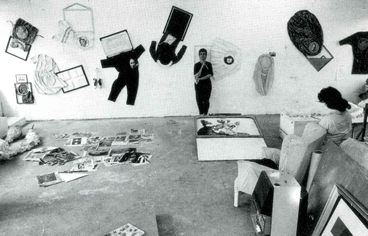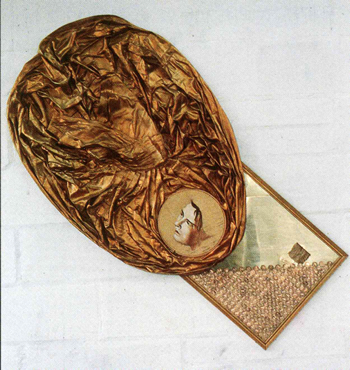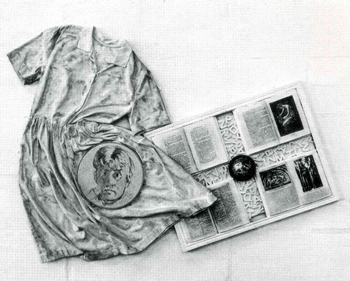“REDRESSING THE BALANCE” 1987

ART PRESS In 'Redressing the Balance' the installation seen for the first time in Berlin, Rose Garrard integrates many pieces of the puzzle she has addressed over twenty years of work, as she makes visible the culture with which she herself has been clothed, by means of the attire which she wore at different crucial stations in her life: her first party dress embroidered with roses, the overalls she used as an art student, the waitresses dress and apron of her first holiday job, the wedding suit she made herself. Her journey into memory achieves objective reality through these authentic relics, kept by her mother in the house near Worcester where she grew up, and she has incorporated them for real into the piece, so that they become its fabric, emblazoning the roles in which she, Rose Garrard, was herself cast. For the spectator, the experience as the piece unfolds becomes even more intimate because she has rubbed raw pigment into the resin, rather than covering anything over with paint, and in each case, an embroidery hoop encloses an untouched section of fabric on which is painted the portrait of a woman artist. Chosen for its connection to women's work and its symbolic roundness, this frame opens a window on to her past, like the monstrance which displays the presence of the relic. Rose Garrard never lapses into piety, but the formulae of the Catholic liturgy have influenced her; alongside each discarded garment the image of a female artist who inspired Garrard appears, like a votive image in a shrine: Louise Nevelson, Carolee Schneeman, Yoko Ono, have joined the pantheon of her earlier works.
Each section of 'Redressing the Balance' represents a phase through which Rose Garrard passed in her adaption to the order of female identity; they are also toilettes (toile, cloth or canvas; tekne, work, technical), outfits women put on to turn their face to the world ... when she narrates her own story in terms of the clothing she wore, she acknowledges the kinship between the concept of the image and the notions of woman, how both femininity and art are fabricated, worked, just as the cloth on which a picture is painted is itself worked or woven, and recognising this condition, she alerts us to its future possibilities with rare intelligence and sympathy, as well as unique imaginative power.
Marina Warner, 'Redressing the Balance', NGBK, Berlin, 1987

ARTIST'S NOTES Work on this installation began during the final stages of my divorce this year, and this experience as well as other personal factors; reaching the age of forty, my mother becoming suddenly 'old', are perhaps what led me to look again at my past. As my mother is becoming increasingly frail we are having to face her eventual move from her home and the reduction of her possessions. She constantly tries to give me things rather than face throwing them away or selling them. In her airing cupboard I found piles of neatly laundered clothes and discovered items of my own clothing, worn at different ages and for different roles ... my first party dress aged four, ballet tutu, waitress uniform, dance dress, wedding suit, etc, which now I couldn't bring myself to throw away. In the studio, I began using the clothes as stepping stones to retrace my own history. My mother has been pointing out objects, (postcards, books, magazines and pictures) which had always been at home but which I hadn't then known were of work by women artists. I want to re-examine my long held belief in the absence of women artists from my formative years and 'redress the balance'. Through the frames with the clothes I also want to identify the periods and systems by which I've been gender-conditioned; how I'd learnt not to see or expect a history of women as artists. Remembering times when I wore these clothes, I began to connect personal and world events (British H Bomb Tests, the deaths of Churchill, Monroe, and the assassination of J.F. Kennedy, the turning away of Cambodian boat people to drown, the death of Rudolf Hess, etc). Using embroidery frames as circular 'stretchers',
I've begun painting relevant self-portraits by 'absent' women artists, onto the clothing and coating the surrounding cloth with resin and pigments. The retracing of my past through these shed 'skins' (the clothes) has become a process of positive rediscovery, each a re-examination of my own process of becoming a woman and an artist.
Rose Garrard 1987

POPULAR PRESS Rose Garrard's 'Redressing the Balance' is a group of wall-mounted assemblages evoking the memory of women artists past and present. Each is Garrard's attempt to establish their identity with the painted image and collected objects. Consistent to them all is an article of clothing and a painted portrait, though in the case of Jan Haworth, an artist prominent in the sixties, persistent research has failed to uncover an image of her. Women disappear from even the most recent history, an example giving added significance to Garrard's rediscovery. Her quest is very much a personal one, but the pragmatic use of materials makes it to a public one. They prompt the viewer to research for themselves.
MC, City Limits, November 27 1988
SITES
'Redressing the Balance' NGBK Berlin Germany
Louise Hallett Gallery London
Drumcroon Wigan Education Art Centre
COMPONENTS
Twelve pieces of clothing from artist's childhood to 1987, on wood, resin and mixed media relief panels, with frames incorporating 'found' objects.